Two Into One Equals
3-D
by Bob Brooke
Before radio and television, people
entertained themselves. An invention in the 1830s—the stereoscope—made
it possible for them to virtually visit far off places. As the 19th
century moved forward, the Victorians, who now had more free time
because of the technological improvements of the Industrial Revolution,
had more time to travel. But those in the lower levels of society made
do with images of foreign places.
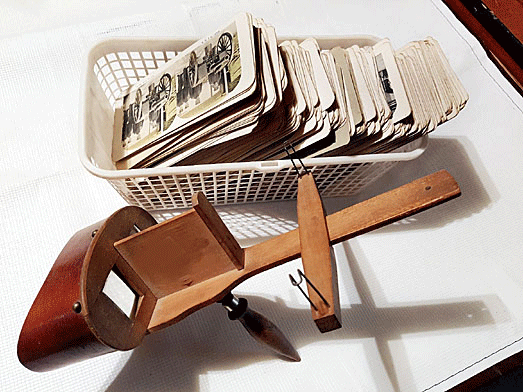
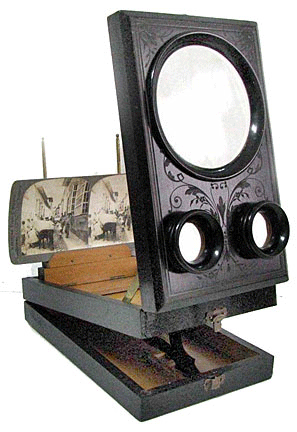 The
most common device that was affordable to most people was the handheld
stereopticon, essentially an instrument in which two photographs of the
same object, taken from slightly different angles, could simultaneously
be viewed, one to each eye. This recreated the way which in natural
vision each eye views an object from a slightly different angle,
separated by several inches, givin humans natural depth perception. A
separate lens focused each picture, and by showing each eye a photograph
taken several inches apart from each other and focused on the same
point, the stereoscope recreated the natural effect of seeing things in
three dimensions. The
most common device that was affordable to most people was the handheld
stereopticon, essentially an instrument in which two photographs of the
same object, taken from slightly different angles, could simultaneously
be viewed, one to each eye. This recreated the way which in natural
vision each eye views an object from a slightly different angle,
separated by several inches, givin humans natural depth perception. A
separate lens focused each picture, and by showing each eye a photograph
taken several inches apart from each other and focused on the same
point, the stereoscope recreated the natural effect of seeing things in
three dimensions.
Early Stereoscopes
Sir Charles Wheatstone invented the earliest stereoscopes, which
optician R. Murray made for him in 1832. On June 21, 1838, Wheatstone
gave a presentation of his invention at the Royal College of London in
which he used a pair of mirrors at 45 degree angles to the user's eyes,
each reflecting a picture located off to the side. It demonstrated the
importance of binocular depth perception by showing that when two
pictures simulating left-eye and right-eye views of the same object are
presented so that each eye sees only the image designed for it, but
apparently in the same location, the brain will fuse the two and accept
them as a view of one solid three-dimensional object. Unfortunately,
Wheatstone introduced his stereoscope the year before the first
practical photographic processes became available, so he had to use
drawings at first. This mirror stereoscope allowed two pictures to be
used if desired.
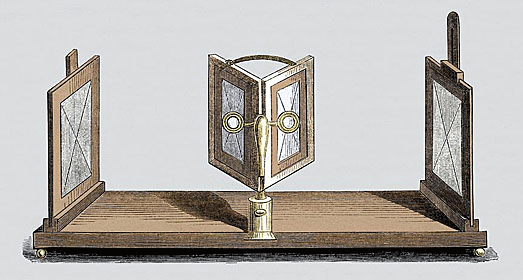
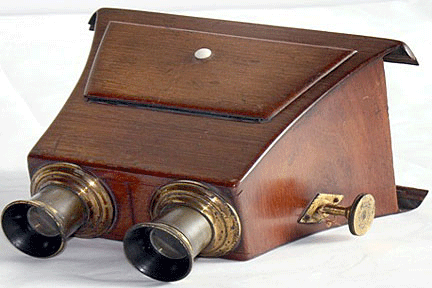 Though
David Brewster didn’t invent the stereoscope, he built a simple
stereoscope without lenses or mirrors, consisting of a wooden box 18
inches long, 7 inches wide, and 4 inches high, which he used to view
drawn landscape transparencies. In 1849, he Though
David Brewster didn’t invent the stereoscope, he built a simple
stereoscope without lenses or mirrors, consisting of a wooden box 18
inches long, 7 inches wide, and 4 inches high, which he used to view
drawn landscape transparencies. In 1849, he
suggested using lenses to unite the dissimilar pictures. This allowed a
reduction in picture size, creating hand-held devices, which became
known as Brewster Stereoscopes, which Queen Victoria admired when he
demonstrated them at the Great Exhibition of 1851.
Queen Victoria Gave the Stereoscope a
Boost
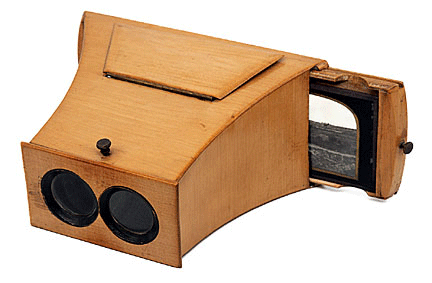 But
Brewster couldn’t find a British instrument maker capable of
constructing his design, so he took it to France, where Jules Duboscq ,
who made stereoscopes and stereoscopic daguerreotypes, improved the
design, allowing the display of Queen Victoria’s likeness to be
displayed at The Great Exhibition. Thanks to her, stereoscopes became a
huge success, with 250,000 of them produced, along with a great number
of stereoviews, stereo cards, stereo pairs or stereographs. Stereoscope
makers sent stereographers throughout the world to capture views for the
new medium and feed the demand for 3D images. They then had cards
printed with these views often with explanatory text. When a user looked
at them through the double-lensed viewer, also called a stereopticon,
they could see both. But
Brewster couldn’t find a British instrument maker capable of
constructing his design, so he took it to France, where Jules Duboscq ,
who made stereoscopes and stereoscopic daguerreotypes, improved the
design, allowing the display of Queen Victoria’s likeness to be
displayed at The Great Exhibition. Thanks to her, stereoscopes became a
huge success, with 250,000 of them produced, along with a great number
of stereoviews, stereo cards, stereo pairs or stereographs. Stereoscope
makers sent stereographers throughout the world to capture views for the
new medium and feed the demand for 3D images. They then had cards
printed with these views often with explanatory text. When a user looked
at them through the double-lensed viewer, also called a stereopticon,
they could see both.
The Handheld Stereopticon
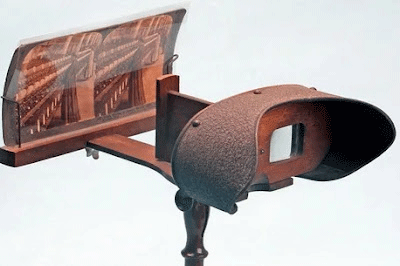 In
1861 Oliver Wendell Holmes created but deliberately didn’t patent a
handheld, streamlined, much more economical viewer than had been
available before. This stereoscope from the 1850s, consisted of two
prismatic lenses and a wooden stand to hold the stereo card. This type
of stereoscope remained in production for a century and is the type most
associated with the name. In
1861 Oliver Wendell Holmes created but deliberately didn’t patent a
handheld, streamlined, much more economical viewer than had been
available before. This stereoscope from the 1850s, consisted of two
prismatic lenses and a wooden stand to hold the stereo card. This type
of stereoscope remained in production for a century and is the type most
associated with the name.
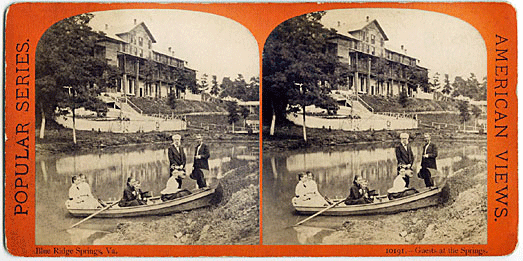
The Multiple View Stereoscope
Another type of viewer was the
multiple view stereoscope which allowed viewing multiple stereoscopic
images in sequence by turning a knob or crank, or pushing down a lever.
Antoine Claudet patented the first one in 1855, but the design of
Alexander Beckers from 1857 formed the basis for many revolving
stereoscopes manufactured from the 1860s onward. The user placed the
images in holders attached to a rotating belt. The belt could usually
hold 50 paper card or glass stereoviews, but there were also large floor
standing models capable of holding 100 or 200 views.
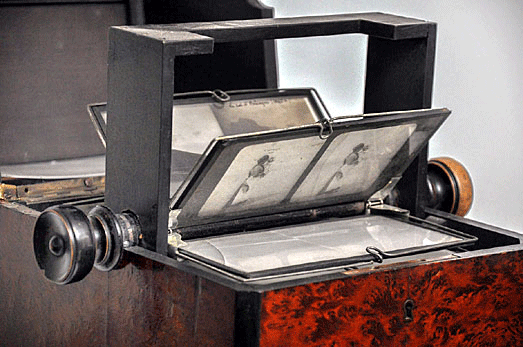
A more advanced multiple view stereoscope was only intended for glass
slides and was especially popular in France, as the printing of stereo
images on glass was a French specialty popular until the 1930s. The
French made most of these devices, but ICA and Ernemann also made them
in Germany. Users placed the glass slides in a bakelite or wooden tray.
Turning a crank or pushing down a lever to lift a slide from the tray,
bringing it into the viewing position. Turning further placed the slide
back in the tray and moved the tray over a rail to select the next
slide. The most sophisticated and well known design was the Taxiphote by
Jules Richard, patented in 1899.
The View-Master Viewer
In the mid-20th century, the View-Master stereoscope, first patented in
1939, featured a rotating cardboard disk which contained image pairs. It
was originally popular as a way for people to virtually travel to
faraway places, but by the 1950s had become a popular toy.
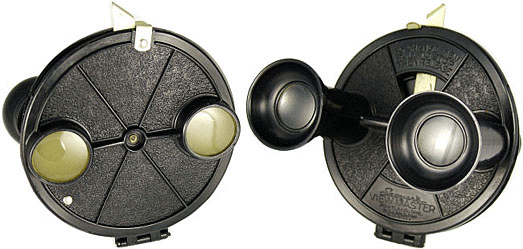
<
Back to Antique Spotlight Archives
Next
Article >
|
